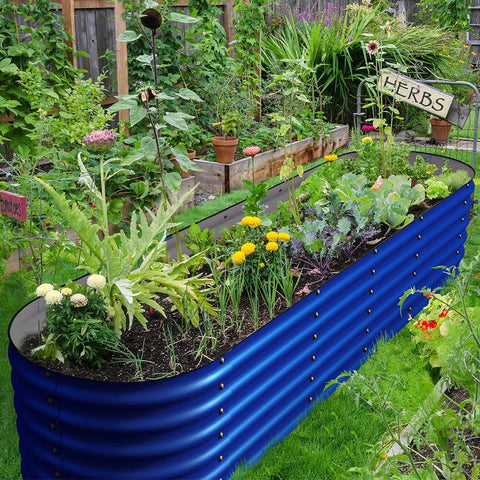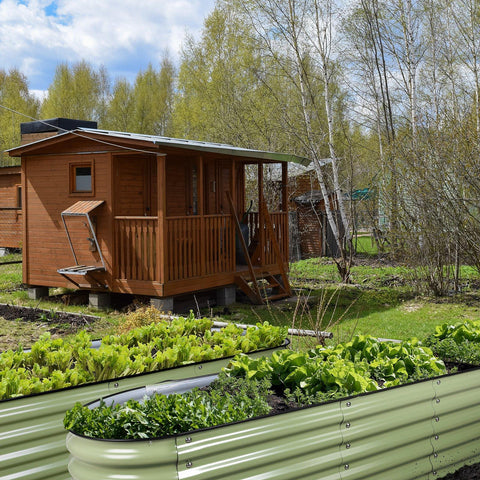Tips from Garden beds layout: Cultivating Beauty, Functionality, and Harmony
Garden beds, with their infinite possibilities, serve as the very heart of a thriving and enchanting landscape. The art of garden bed layout involves a symphony of design elements, where creativity meets functionality to create an outdoor haven that captivates the senses and nurtures the soul. In this article, we will delve deeper into the significance of garden bed layout, exploring each aspect in detail to understand how thoughtful planning can transform an ordinary garden into a breathtaking masterpiece.
Maximizing Space and Elevating Aesthetics
A well-designed garden bed layout is akin to a masterpiece on a canvas. Each brushstroke, in this case, every plant, structure, and pathway, is carefully placed to maximize the available space and elevate the garden's aesthetics. The strategic arrangement of plants with varying heights and colors creates a delightful visual balance, drawing the eyes to explore every corner of the garden. Embracing curved edges along the pathways adds a touch of elegance, while focal points like garden sculptures or decorative planters become captivating centerpieces that enthrall all who wander through the garden.
Enhancing Accessibility and Functionality
Gardeners who embrace the principles of garden bed layout experience the joy of an efficient and functional outdoor space. Paths and walkways are thoughtfully positioned to provide easy access to all areas of the garden, making plant care and maintenance a delightful breeze. Raised beds or well-defined borders not only contribute to the garden's aesthetics but also serve practical purposes, preventing soil erosion and facilitating a systematic approach to gardening tasks. A garden with a well-planned layout not only enhances its beauty but also transforms the act of gardening into a fulfilling and enjoyable experience.

Creating Harmonious Plant Combinations
The magic of a garden lies in the skillful combination of plants that harmonize and thrive together. Garden bed layout offers a palette of possibilities, where gardeners can experiment with a delightful array of plant combinations. Consider the juxtaposition of tall, swaying grasses with the delicate blooms of perennial flowers or the vibrant hues of annuals dancing around the sturdiness of evergreen shrubs. Embracing companion planting techniques, such as intermingling fragrant herbs with vegetables, not only adds charm but also fosters ecological balance by deterring pests and promoting pollination.
Ensuring Year-Round Interest
A well-conceived garden bed layout is a symphony of colors that never ceases to amaze throughout the seasons. To ensure year-round interest, gardeners carefully select plants that offer an ever-changing display of beauty. Early spring blooms usher in the season with splashes of color, followed by the lush foliage and vibrant flowers of summer. As autumn sets in, the fiery hues of deciduous trees and shrubs steal the show, eventually giving way to the serene beauty of evergreens that provide a soothing backdrop in the winter months.
Promoting Biodiversity and Ecological Balance
Garden beds, when thoughtfully laid out, become microcosms of ecological balance and biodiversity. By embracing a diverse range of plant species, gardeners attract a myriad of beneficial insects, birds, and butterflies that contribute to the ecosystem's health. In turn, these visitors become allies in the battle against pests, ensuring a thriving and balanced garden. The use of native plants further promotes environmental sustainability, as they are well-adapted to the local climate and support native wildlife.
Encouraging Relaxation and Well-Being
Beyond its visual appeal and ecological significance, a garden bed layout has the power to nurture the well-being of those who wander through its lush pathways. The symphony of colors, textures, and fragrances creates a sensory experience that calms the mind and lifts the spirit. The soothing sound of rustling leaves, the chirping of birds, and the gentle swaying of flowers in the breeze all combine to form a natural symphony of tranquility. Gardens with carefully planned layouts become sanctuaries of peace, where one can escape the hustle and bustle of everyday life and find solace in the embrace of nature.
Choosing the Right Garden Bed Location
The first step in garden bed layout is selecting the ideal location. Consider the amount of sunlight the area receives throughout the day and the prevailing wind direction. Full sun exposure is generally preferred for most plants, but if you have shade-loving species, positioning the beds accordingly is essential. Moreover, think about the proximity to a water source for convenient irrigation and accessibility for regular maintenance.
Preparing the Soil
The foundation of any successful garden bed lies in the quality of the soil. Before planting, ensure the soil is well-draining, fertile, and rich in nutrients. You can amend the soil with compost or organic matter to improve its structure and enhance nutrient availability. Conduct a soil test to determine the pH level and nutrient content, enabling you to make targeted amendments based on your desired plant selection.
Considering Garden Bed Size and Shape
Garden bed layout includes careful consideration of the size and shape of each bed. The size depends on the available space, your gardening goals, and the number of plants you wish to grow. Remember to allow ample space between each bed for ease of movement and to avoid overcrowding. Experiment with various shapes, such as rectangular, circular, or irregular, to add visual interest to the overall landscape.

Zoning Your Garden Beds
Creating zones within your garden beds can help optimize plant growth and improve garden management. Group plants with similar water and sunlight requirements together, ensuring efficient irrigation and care. Consider organizing beds based on plant categories, such as herbs, vegetables, perennials, and annuals, to create themed areas that add a dynamic charm to the garden.
Utilizing Vertical Space
Vertical gardening is a clever technique to maximize space and introduce an architectural element to your garden. Incorporate trellises, stakes, or wall-mounted planters to grow climbing plants and vining vegetables. Vertical structures not only provide support but also add dimension and visual interest, making your garden beds appear larger and more lush.
Incorporating Hardscaping Features
In addition to plants, hardscaping elements contribute to the overall layout of garden beds. Consider adding pathways made of gravel, stepping stones, or pavers to lead visitors through the garden and define the space. Raised beds constructed from stone or wood add texture and structure, while garden edging enhances the beds' definition and prevents encroachment by grass and weeds.
Creating Focal Points
Focal points are key elements in garden bed layout that draw attention and add a sense of unity to the space. Garden sculptures, birdbaths, water features, or strategically placed containers filled with vibrant flowers serve as eye-catching centerpieces. These focal points not only add interest but also create a sense of coherence, leading the eye to explore the surrounding beauty.
Seasonal Planting Strategies
Plan your garden bed layout with an eye towards seasonal changes. Consider planting early-blooming bulbs or perennials to welcome spring with a burst of color. As summer approaches, mix in annual flowers to maintain a vibrant display throughout the warmer months. Embrace fall-blooming perennials and shrubs to ensure a striking appearance as the seasons transition, and incorporate evergreens for winter interest and structure.
Companion Planting Benefits
Companion planting is a practice that involves strategically growing different plants together to mutually benefit one another. For example, planting marigolds alongside tomatoes helps deter harmful insects, while basil improves the growth and flavor of tomatoes. Understanding the principles of companion planting allows you to create a harmonious ecosystem within your garden beds, fostering healthier plants and reducing the need for chemical interventions.
Thematic Garden Beds
Embrace the creative side of garden bed layout by designing thematic garden beds. Create a sensory garden filled with fragrant blooms, herbs, and textured foliage, enticing visitors to touch, smell, and experience nature up close. Consider an edible garden bed that combines vegetables, fruits, and edible flowers, allowing you to enjoy the freshest produce right from your backyard. Themed garden beds provide an opportunity to express your personal style and passions while curating a unique and captivating landscape.

Container Gardening within Beds
Incorporating containers within garden beds is an excellent way to add versatility and flexibility to your layout. Use large containers to grow small trees or shrubs, creating focal points that can be rearranged or replaced easily. Smaller containers can house herbs or annuals, allowing for easy repositioning and experimentation with color combinations. Container gardening also provides an opportunity to grow plants that may have specific soil or drainage requirements.
Garden Bed Maintenance and Renewal
A well-planned garden bed layout should also consider the ease of maintenance and renewal. Incorporate low-maintenance perennials to reduce the need for frequent replanting. Prioritize organic mulching to suppress weeds, retain moisture, and enrich the soil over time. Regularly assess the health and vitality of your garden beds, replacing plants that may have outgrown their space or are no longer thriving.
Incorporating Garden Bed Lighting
Extend the enjoyment of your garden beds beyond daylight hours by incorporating outdoor lighting. Soft, warm lighting creates an inviting ambiance, allowing you and your guests to appreciate the garden's beauty even after the sun sets. Use spotlights to highlight focal points or gently illuminate pathways for safe and pleasant nighttime strolls. Garden bed lighting adds an enchanting touch, creating a magical atmosphere that enhances the overall garden experience.
The Joy of Garden Bed Layout
In conclusion, the art of garden bed layout is a captivating journey that combines aesthetics with purpose. With thoughtful planning and creativity, you can transform your garden into an exquisite haven that delights the senses, fosters biodiversity, and provides a sanctuary for relaxation and well-being. Embrace the joy of curating your garden beds, experimenting with plants, colors, and themes to create an outdoor sanctuary that reflects your unique style and brings endless satisfaction with each season's changing beauty. Let the magic of garden bed layout infuse your landscape with harmony, vitality, and boundless inspiration. Happy gardening!
